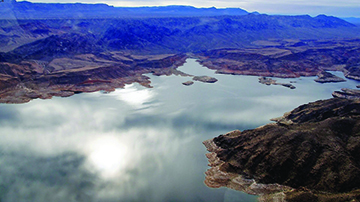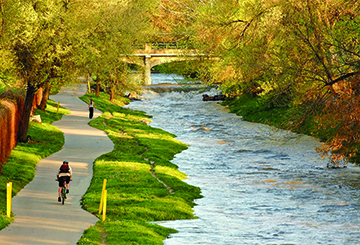With Colorado River Sapped By Drought, Denver, Suburbs Are Scrambling For Water

Lake Mead In Need: With the Colorado River at historic lows, Lake Mead Reservoir may not have enough water to generate hydropower, which would have a devastating impact on Denver.
Denver has a water crisis! The city and surrounding suburbs are running out of H2O. Why? Drought and climate change are draining the Colorado River dry. The river and watershed declined 20% this century. In 2021 the first-ever federal emergency water shortage declaration was declared. The lines of supply and demand for the Colorado River were crossed in 2000. Colorado and other western states were taking more water than the river had to give resulting in drainage of the two biggest reservoirs in the country, Lake Mead and Lake Powell.
It’s doubtful that all 1,450 miles of the Colorado River will turn to dust. But Lake Mead and Lake Powell are at historic lows. If water levels dip much lower, Colorado’s northernmost reservoir won’t have enough in the tank to both fill Lake Mead downstream and generate any hydropower, which would have devastating effects on the electricity grid to our city-state, plus a half-dozen other western states.
So far Colorado has been able to meet the water needs of Denver’s 5.8 million Front Range residents. But as the population surges while climate change escalates, Denver Water and suburban cities are suddenly scrambling to secure and shore up supplies. Denver Water gets about half of its supply from the Colorado River system. Water for more than one million homes on the Front Range could be lost and thousands of acres of farmland on the Western Slope and Eastern Plains may go dry. Remember, Colorado is also legally required to supply water to downstream states.
Water For Denver Water

Creek Flow Improved: A stretch of Cherry Creek that flows through Denver was restored at the end of 2021. Stormwater runoff and water quality was reestablished after eight-years of work.
Denver Water — the city’s chief water utility — collects rain and snow across a 4,000-square-mile area — capturing about 94 billion gallons in an average year. Since half of Denver’s drinking water comes from tributaries of the Colorado River on the west side of the Rocky Mountains — and the river basin has experienced a megadrought from the last two decades — the utility and the city are preparing for a future of increasing scarcity by diversifying water sources and ramping up conservation and efficiency efforts.
Summit County’s Lake Dillon Reservoir — Denver Water’s man-made and owned reservoir — is one of the largest sources of drinking water for Denver. With surging population growth in metro Denver, it may soon leave Dillon high and dry during most summers. Experts predict between 19 and 24 dry years during the next 26-year period. By late summer the utility begins piping water out of Dillon Reservoir via the Roberts Tunnel — a 23-mile pipe that runs under the Continental Divide and into the North Fork of the South Platte River — delivering it to Denver Water.
In June of last year, the city and county of Denver and the U.S. Army Corps of Engineers started moving forward on a $550.3 million project to improve the South Platte River and its tributaries. The work aims to restore a highly degraded river and boost habitat while reducing flood risks along the river. Also, a stretch of Cherry Creek that flows through Denver — between E. 6th Ave. on the North and Colorado Blvd. on the east — was restored at the end of 2021 after eight-years of work. The finished work improves stormwater runoff and water quality. Further, wildlife habitat and recreation were enhanced. In addition, Chatfield Dam — originally built for flood protection — is now also being used for water storage. Denver Water maintains a storage pool of more than 27,000 acre-feet. Water storage at Chatfield is also helping Centennial, Castle Rock, and Castle Pines supply their growing populations.
Serious Suburb Steps

Turf Tradeoff: Denver and suburban cities are focusing on turf replacement plans as the next reservoir of water. Adoption is just beginning but it’s seen as the cheapest, fastest, most reliable new supply.
Denver’s suburbs — the center of housing sprawl — continue to boom, creating a scramble for sustainable water supplies as they realize that they’re running out of water. Communities such as Aurora, Arvada, and Castle Rock are taking serious steps to meet current demands, recognizing that water supplies are likely to worsen. They face higher water prices, dwindling supply, plus older collection and treatment systems.
Aurora no longer allows grass in medians or decorative spots at offices, plus no home lawns front or back. Aurora has also banned new golf courses. Aurora Water will buy existing turf plus design a low-water garden for free, and pay material costs up to $3,000 for 500-sq.-ft. Arvada has yet to ban turf but has doubled connection fees. Fast-growing Castle Rock, however, has banned turf in front yards of new homes and is offering developers steep fee discounts for water-saving. Without a turf ban, Denver Water is working with the city on updated building codes that may result in stronger turf limits. Denver is also considering a cap on irrigation at 7.5 gallons of potable water per square foot.
Lastly, a new turf replacement program is set to roll out statewide this year. It will pay homeowners to convert some of the grass in urban and residential yards into more water-efficient landscaping. It is the first time the State of Colorado had dedicated funds expressly to turf replacement. The bottom line: Denver and Colorado are focusing on turf replacement programs as the city-state’s next reservoir of water. For the foreseeable future it is likely to be the cheapest, fastest, and most reliable form of new supply.
The Heat Is On

Chatfield Storage Space: Built as a flood shield, Chatfield Dam is now used for water storage. Denver Water keeps 27,000 acre-feet. Centennial, Castle Rock, and Castle Pines also save water.
Average temperatures in Denver and statewide have increased by 2.0°F over the past 30 years, according to the Colorado Water Conservation Board. However, heat waves are becoming more common, snow is melting earlier in spring, and less water flows through the Colorado River.
Furthermore, the frequency and intensity of heat waves are increasing even in places with cooler average temperatures. Warmer temperatures will affect evaporation rates in our rivers, streams and reservoirs, possible making less water available for beneficial use.
Recent wet weather hasn’t ended the drought, and won’t cure the driest period in the past 1,200 years. Moreover, researchers say the state is likely to see 50% to 60% less snow as the next century approaches. Less stream flow in Colorado probably also means the Centennial State will increasingly look more like Arizona and New Mexico.
Trio Of Neighboring Cities Face Dire River Reckoning
As Valley communities scramble to meet the needs of residents as water withers in the Colorado River, a proposal by the Biden Administration would almost entirely cut off river deliveries to Phoenix, Tucson, and Las Vegas. That’s the option unless California agrees to proposed equal cuts for all three Colorado River basin states. The proposals give Secretary of Interior Deb Haaland authority to cut water use on the river.
